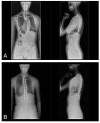Posterior Correction and Fusion Using a 4D Anatomical Spinal Reconstruction Technique Improves Postural Stability Under the Eye-Closed Condition in Patients with Adolescent Idiopathic Scoliosis
- PMID: 39518504
- PMCID: PMC11546169
- DOI: 10.3390/jcm13216366
Posterior Correction and Fusion Using a 4D Anatomical Spinal Reconstruction Technique Improves Postural Stability Under the Eye-Closed Condition in Patients with Adolescent Idiopathic Scoliosis
Abstract
Background: Patients with adolescent idiopathic scoliosis (AIS) has been reported to exhibit impaired postural stability. Posterior correction and fusion using four-dimensional (4D) anatomical spinal reconstruction techniques may improve postural stability to correct the spine for optimal anatomical alignment. This prospective study aimed to determine the effect of posterior correction and fusion using a 4D anatomical spinal reconstruction technique on postural stability in the eye-open and eye-closed standing position in patients with thoracic AIS. Methods: Thirty-three patients with AIS, excluding those with Lenke type 5C AIS, participated in the study. The mean and standard deviation of the minimum values of the time-to-boundary (TTB) were determined. All patients were asked to perform the quiet standing position under the eye-open and eye-closed condition on a force plate preoperatively and at 1 week and 2 years postoperatively. The TTB value was calculated from the velocity and distance to the foot boundary of the acquired center-of-pressure data. Results: Under the eye-closed condition, the mean and standard deviation of the minimum TTB were significantly higher at 2 years postoperatively than preoperatively and at 1 week postoperatively. The mean and standard deviation of the minimum TTB values were significantly lower at 1 week postoperatively than preoperatively. Conclusions: The results of this study suggest that surgery using the 4D anatomical spinal reconstruction technique reduces postural stability immediately after surgery; however, it improves postural stability at 2 years compared to the preoperative values.
Keywords: adolescent idiopathic scoliosis; anatomical spinal reconstruction; center of pressure; force plate; prospective study; time-to-boundary.
Conflict of interest statement
The authors declare no conflicts of interest.
Figures




Similar articles
-
Effects of Posterior Spinal Correction and Fusion on Postural Stability in Patients with Adolescent Idiopathic Scoliosis.J Clin Med. 2022 Dec 29;12(1):270. doi: 10.3390/jcm12010270. J Clin Med. 2022. PMID: 36615069 Free PMC article.
-
Four-Dimensional Anatomical Spinal Reconstruction in Thoracic Adolescent Idiopathic Scoliosis.JBJS Essent Surg Tech. 2022 Feb 16;12(1):e21.00038. doi: 10.2106/JBJS.ST.21.00038. eCollection 2022 Jan-Mar. JBJS Essent Surg Tech. 2022. PMID: 35692722 Free PMC article.
-
Postoperative changes in sagittal spinopelvic alignment in sitting position in adolescents with idiopathic thoracic scoliosis treated with posterior fusion: an initial analysis.J Neurosurg Pediatr. 2018 Jul;22(1):74-80. doi: 10.3171/2018.2.PEDS17687. Epub 2018 May 4. J Neurosurg Pediatr. 2018. PMID: 29726791
-
Adolescent idiopathic scoliosis and spinal fusion do not substantially impact on postural balance.Scoliosis. 2015 Jun 9;10:18. doi: 10.1186/s13013-015-0042-y. eCollection 2015. Scoliosis. 2015. PMID: 26056528 Free PMC article.
-
Selective Thoracic Fusion of Lenke I and II Curves Affects Sagittal Profiles But Not Sagittal or Spinopelvic Alignment: A Case-Control Study.Spine (Phila Pa 1976). 2015 Jun 15;40(12):926-34. doi: 10.1097/BRS.0000000000000861. Spine (Phila Pa 1976). 2015. PMID: 26067149 Review.
Cited by
-
Effects of Acute Lateral Ankle Sprain on Spinal Reflex Excitability and Time-to-Boundary Postural Control in Single-Leg Stance.Healthcare (Basel). 2025 Jan 14;13(2):149. doi: 10.3390/healthcare13020149. Healthcare (Basel). 2025. PMID: 39857176 Free PMC article.
References
-
- Dufvenberg M., Adeyemi F., Rajendran I., Öberg B., Abbott A. Does postural stability differ between adolescents with idiopathic scoliosis and typically developed? A systematic literature review and meta-analysis. Scoliosis Spinal Disord. 2018;13:19. doi: 10.1186/s13013-018-0163-1. - DOI - PMC - PubMed
LinkOut - more resources
Full Text Sources

